Project Report: Royale Pizza - Menu, Facilities, and Sales Improvement
VerifiedAdded on 2022/09/17
|10
|1913
|34
Project
AI Summary
This project report analyzes Royale Pizza's plan to enhance its business operations. The restaurant aims to expand its menu by adding new food items, renovate its dining space, and improve its sales processes. The report details the project goals, scope, and the project delivery methodology, which includes design, procurement, construction, and installation phases. It identifies stakeholders, constraints, and required changes, such as the removal of staircases to increase kitchen space. The project follows a lifecycle approach: initiation, planning, execution, and closure. The report emphasizes the importance of project management procedures for achieving desired results, including increasing revenue, reducing food waste, and improving customer satisfaction. Quality supervisors are appointed to monitor safety standards and ensure the successful completion of the project within a specified timeframe and budget.
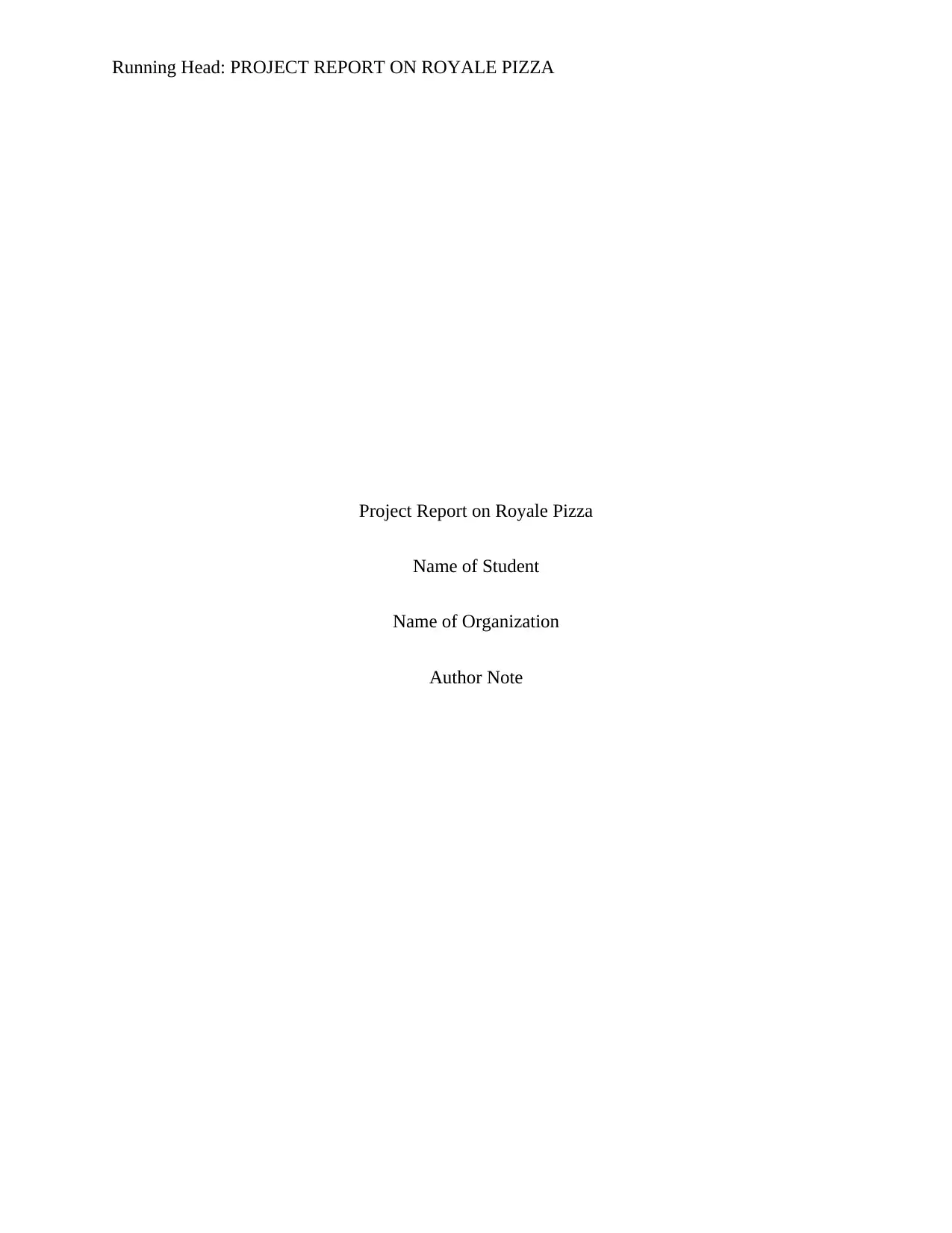
Running Head: PROJECT REPORT ON ROYALE PIZZA
Project Report on Royale Pizza
Name of Student
Name of Organization
Author Note
Project Report on Royale Pizza
Name of Student
Name of Organization
Author Note
Paraphrase This Document
Need a fresh take? Get an instant paraphrase of this document with our AI Paraphraser
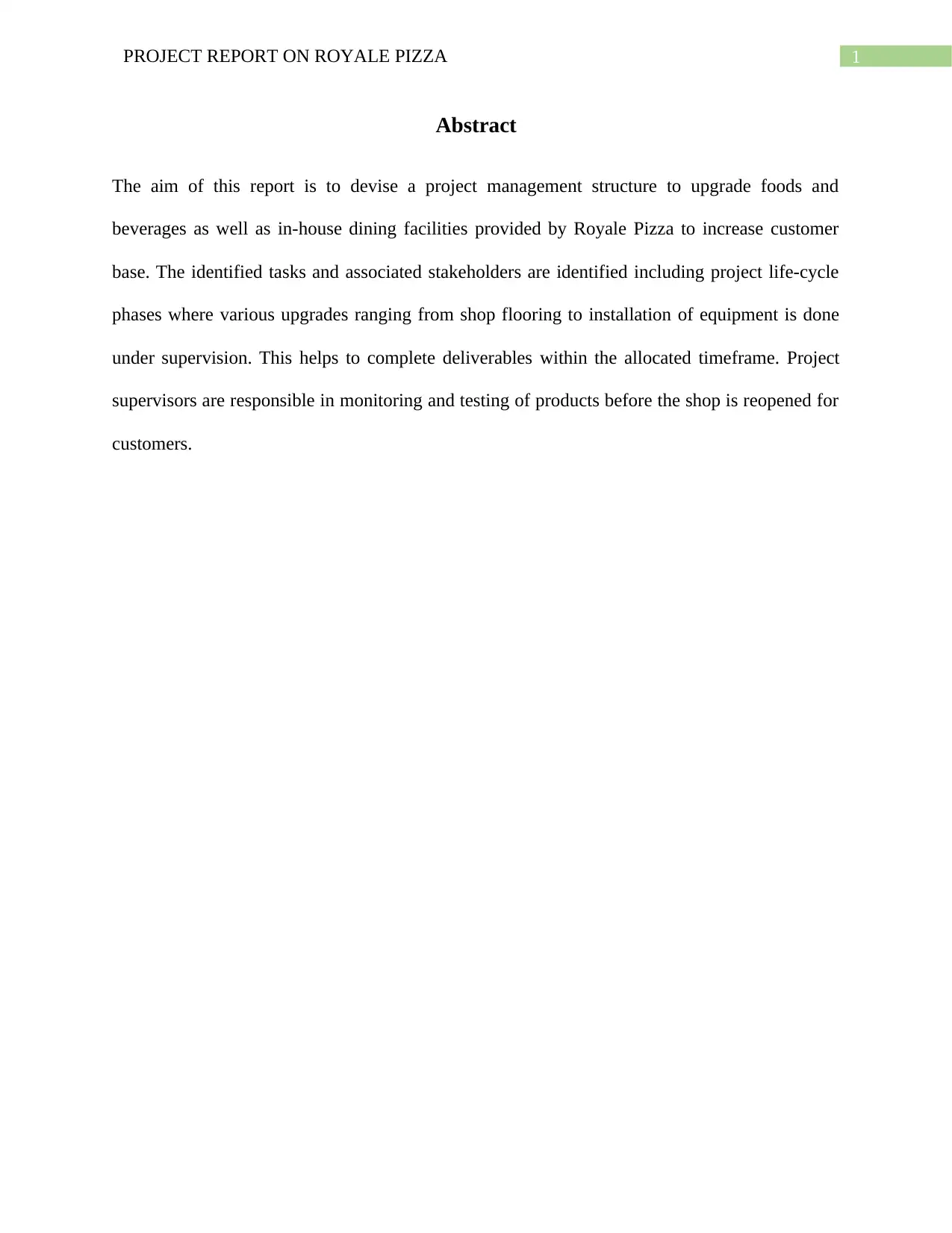
1PROJECT REPORT ON ROYALE PIZZA
Abstract
The aim of this report is to devise a project management structure to upgrade foods and
beverages as well as in-house dining facilities provided by Royale Pizza to increase customer
base. The identified tasks and associated stakeholders are identified including project life-cycle
phases where various upgrades ranging from shop flooring to installation of equipment is done
under supervision. This helps to complete deliverables within the allocated timeframe. Project
supervisors are responsible in monitoring and testing of products before the shop is reopened for
customers.
Abstract
The aim of this report is to devise a project management structure to upgrade foods and
beverages as well as in-house dining facilities provided by Royale Pizza to increase customer
base. The identified tasks and associated stakeholders are identified including project life-cycle
phases where various upgrades ranging from shop flooring to installation of equipment is done
under supervision. This helps to complete deliverables within the allocated timeframe. Project
supervisors are responsible in monitoring and testing of products before the shop is reopened for
customers.
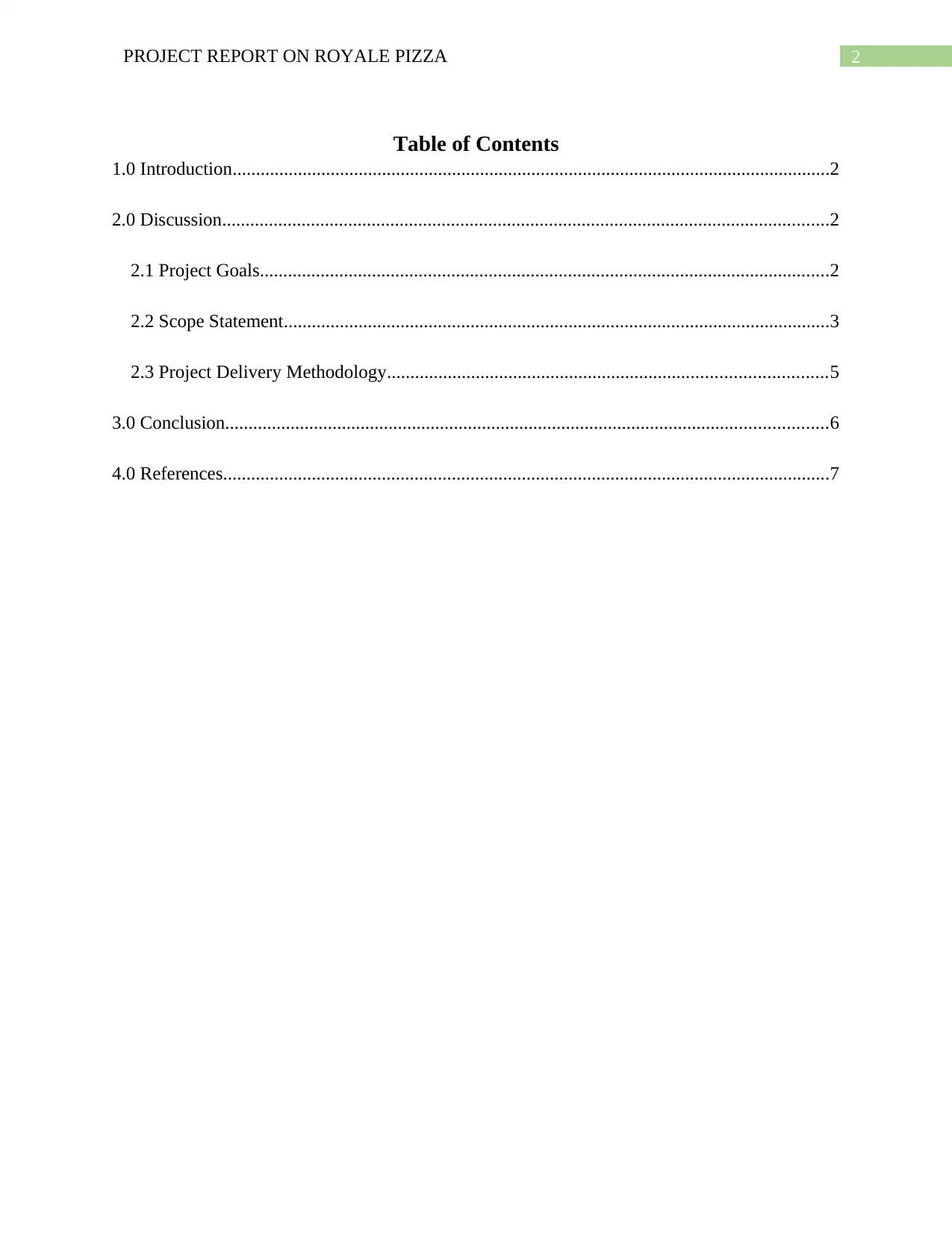
2PROJECT REPORT ON ROYALE PIZZA
Table of Contents
1.0 Introduction................................................................................................................................2
2.0 Discussion..................................................................................................................................2
2.1 Project Goals..........................................................................................................................2
2.2 Scope Statement.....................................................................................................................3
2.3 Project Delivery Methodology..............................................................................................5
3.0 Conclusion.................................................................................................................................6
4.0 References..................................................................................................................................7
Table of Contents
1.0 Introduction................................................................................................................................2
2.0 Discussion..................................................................................................................................2
2.1 Project Goals..........................................................................................................................2
2.2 Scope Statement.....................................................................................................................3
2.3 Project Delivery Methodology..............................................................................................5
3.0 Conclusion.................................................................................................................................6
4.0 References..................................................................................................................................7
⊘ This is a preview!⊘
Do you want full access?
Subscribe today to unlock all pages.

Trusted by 1+ million students worldwide
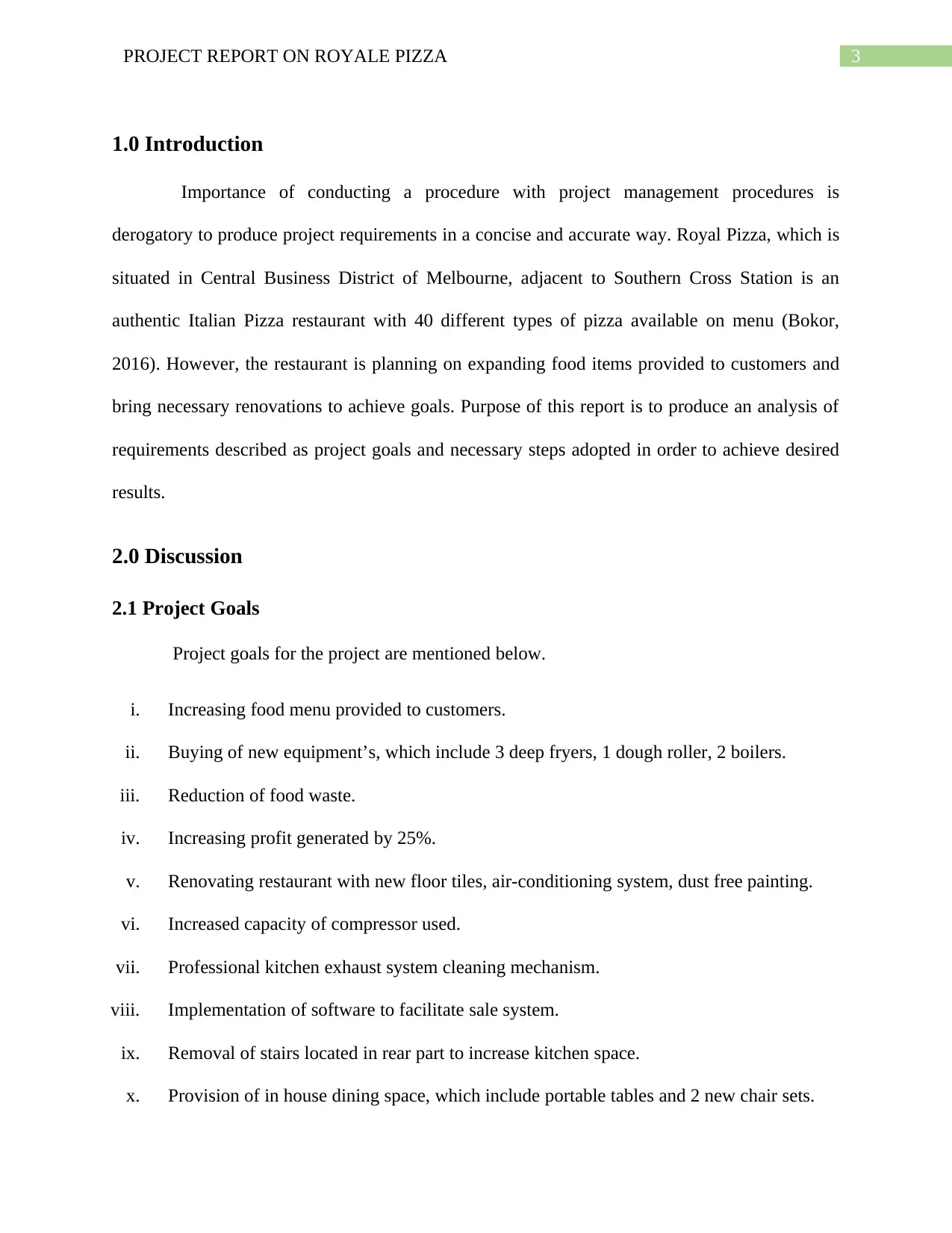
3PROJECT REPORT ON ROYALE PIZZA
1.0 Introduction
Importance of conducting a procedure with project management procedures is
derogatory to produce project requirements in a concise and accurate way. Royal Pizza, which is
situated in Central Business District of Melbourne, adjacent to Southern Cross Station is an
authentic Italian Pizza restaurant with 40 different types of pizza available on menu (Bokor,
2016). However, the restaurant is planning on expanding food items provided to customers and
bring necessary renovations to achieve goals. Purpose of this report is to produce an analysis of
requirements described as project goals and necessary steps adopted in order to achieve desired
results.
2.0 Discussion
2.1 Project Goals
Project goals for the project are mentioned below.
i. Increasing food menu provided to customers.
ii. Buying of new equipment’s, which include 3 deep fryers, 1 dough roller, 2 boilers.
iii. Reduction of food waste.
iv. Increasing profit generated by 25%.
v. Renovating restaurant with new floor tiles, air-conditioning system, dust free painting.
vi. Increased capacity of compressor used.
vii. Professional kitchen exhaust system cleaning mechanism.
viii. Implementation of software to facilitate sale system.
ix. Removal of stairs located in rear part to increase kitchen space.
x. Provision of in house dining space, which include portable tables and 2 new chair sets.
1.0 Introduction
Importance of conducting a procedure with project management procedures is
derogatory to produce project requirements in a concise and accurate way. Royal Pizza, which is
situated in Central Business District of Melbourne, adjacent to Southern Cross Station is an
authentic Italian Pizza restaurant with 40 different types of pizza available on menu (Bokor,
2016). However, the restaurant is planning on expanding food items provided to customers and
bring necessary renovations to achieve goals. Purpose of this report is to produce an analysis of
requirements described as project goals and necessary steps adopted in order to achieve desired
results.
2.0 Discussion
2.1 Project Goals
Project goals for the project are mentioned below.
i. Increasing food menu provided to customers.
ii. Buying of new equipment’s, which include 3 deep fryers, 1 dough roller, 2 boilers.
iii. Reduction of food waste.
iv. Increasing profit generated by 25%.
v. Renovating restaurant with new floor tiles, air-conditioning system, dust free painting.
vi. Increased capacity of compressor used.
vii. Professional kitchen exhaust system cleaning mechanism.
viii. Implementation of software to facilitate sale system.
ix. Removal of stairs located in rear part to increase kitchen space.
x. Provision of in house dining space, which include portable tables and 2 new chair sets.
Paraphrase This Document
Need a fresh take? Get an instant paraphrase of this document with our AI Paraphraser
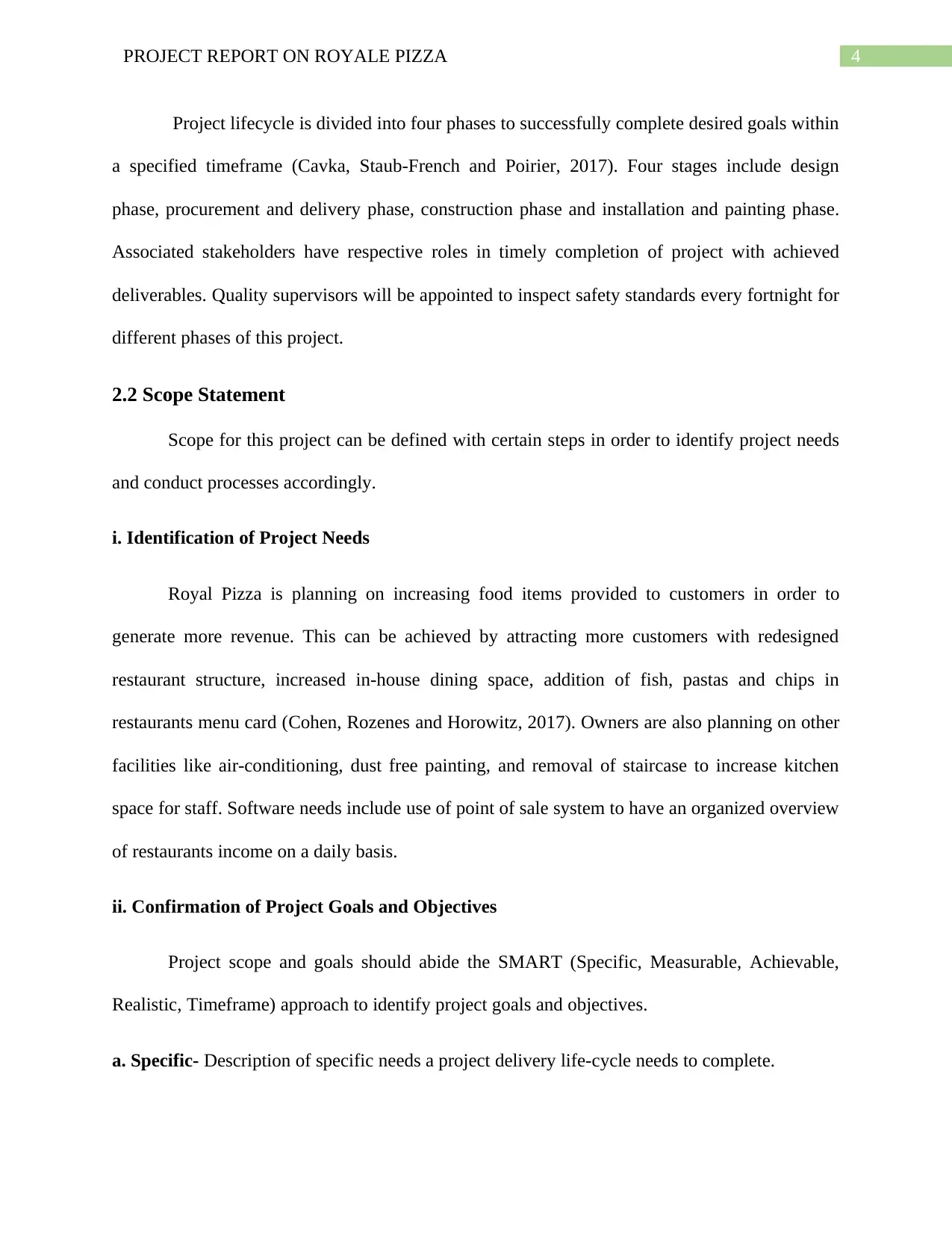
4PROJECT REPORT ON ROYALE PIZZA
Project lifecycle is divided into four phases to successfully complete desired goals within
a specified timeframe (Cavka, Staub-French and Poirier, 2017). Four stages include design
phase, procurement and delivery phase, construction phase and installation and painting phase.
Associated stakeholders have respective roles in timely completion of project with achieved
deliverables. Quality supervisors will be appointed to inspect safety standards every fortnight for
different phases of this project.
2.2 Scope Statement
Scope for this project can be defined with certain steps in order to identify project needs
and conduct processes accordingly.
i. Identification of Project Needs
Royal Pizza is planning on increasing food items provided to customers in order to
generate more revenue. This can be achieved by attracting more customers with redesigned
restaurant structure, increased in-house dining space, addition of fish, pastas and chips in
restaurants menu card (Cohen, Rozenes and Horowitz, 2017). Owners are also planning on other
facilities like air-conditioning, dust free painting, and removal of staircase to increase kitchen
space for staff. Software needs include use of point of sale system to have an organized overview
of restaurants income on a daily basis.
ii. Confirmation of Project Goals and Objectives
Project scope and goals should abide the SMART (Specific, Measurable, Achievable,
Realistic, Timeframe) approach to identify project goals and objectives.
a. Specific- Description of specific needs a project delivery life-cycle needs to complete.
Project lifecycle is divided into four phases to successfully complete desired goals within
a specified timeframe (Cavka, Staub-French and Poirier, 2017). Four stages include design
phase, procurement and delivery phase, construction phase and installation and painting phase.
Associated stakeholders have respective roles in timely completion of project with achieved
deliverables. Quality supervisors will be appointed to inspect safety standards every fortnight for
different phases of this project.
2.2 Scope Statement
Scope for this project can be defined with certain steps in order to identify project needs
and conduct processes accordingly.
i. Identification of Project Needs
Royal Pizza is planning on increasing food items provided to customers in order to
generate more revenue. This can be achieved by attracting more customers with redesigned
restaurant structure, increased in-house dining space, addition of fish, pastas and chips in
restaurants menu card (Cohen, Rozenes and Horowitz, 2017). Owners are also planning on other
facilities like air-conditioning, dust free painting, and removal of staircase to increase kitchen
space for staff. Software needs include use of point of sale system to have an organized overview
of restaurants income on a daily basis.
ii. Confirmation of Project Goals and Objectives
Project scope and goals should abide the SMART (Specific, Measurable, Achievable,
Realistic, Timeframe) approach to identify project goals and objectives.
a. Specific- Description of specific needs a project delivery life-cycle needs to complete.
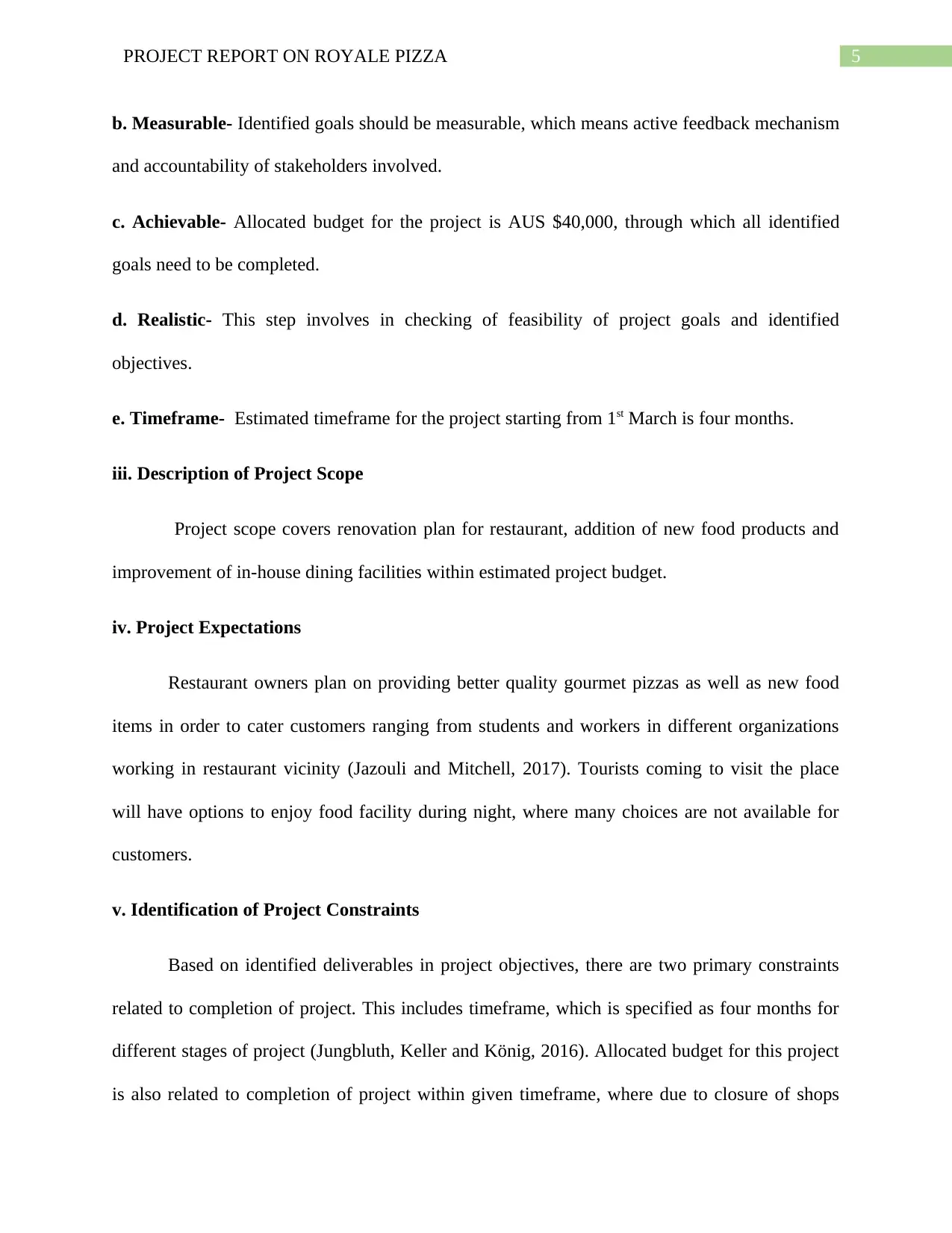
5PROJECT REPORT ON ROYALE PIZZA
b. Measurable- Identified goals should be measurable, which means active feedback mechanism
and accountability of stakeholders involved.
c. Achievable- Allocated budget for the project is AUS $40,000, through which all identified
goals need to be completed.
d. Realistic- This step involves in checking of feasibility of project goals and identified
objectives.
e. Timeframe- Estimated timeframe for the project starting from 1st March is four months.
iii. Description of Project Scope
Project scope covers renovation plan for restaurant, addition of new food products and
improvement of in-house dining facilities within estimated project budget.
iv. Project Expectations
Restaurant owners plan on providing better quality gourmet pizzas as well as new food
items in order to cater customers ranging from students and workers in different organizations
working in restaurant vicinity (Jazouli and Mitchell, 2017). Tourists coming to visit the place
will have options to enjoy food facility during night, where many choices are not available for
customers.
v. Identification of Project Constraints
Based on identified deliverables in project objectives, there are two primary constraints
related to completion of project. This includes timeframe, which is specified as four months for
different stages of project (Jungbluth, Keller and König, 2016). Allocated budget for this project
is also related to completion of project within given timeframe, where due to closure of shops
b. Measurable- Identified goals should be measurable, which means active feedback mechanism
and accountability of stakeholders involved.
c. Achievable- Allocated budget for the project is AUS $40,000, through which all identified
goals need to be completed.
d. Realistic- This step involves in checking of feasibility of project goals and identified
objectives.
e. Timeframe- Estimated timeframe for the project starting from 1st March is four months.
iii. Description of Project Scope
Project scope covers renovation plan for restaurant, addition of new food products and
improvement of in-house dining facilities within estimated project budget.
iv. Project Expectations
Restaurant owners plan on providing better quality gourmet pizzas as well as new food
items in order to cater customers ranging from students and workers in different organizations
working in restaurant vicinity (Jazouli and Mitchell, 2017). Tourists coming to visit the place
will have options to enjoy food facility during night, where many choices are not available for
customers.
v. Identification of Project Constraints
Based on identified deliverables in project objectives, there are two primary constraints
related to completion of project. This includes timeframe, which is specified as four months for
different stages of project (Jungbluth, Keller and König, 2016). Allocated budget for this project
is also related to completion of project within given timeframe, where due to closure of shops
⊘ This is a preview!⊘
Do you want full access?
Subscribe today to unlock all pages.

Trusted by 1+ million students worldwide
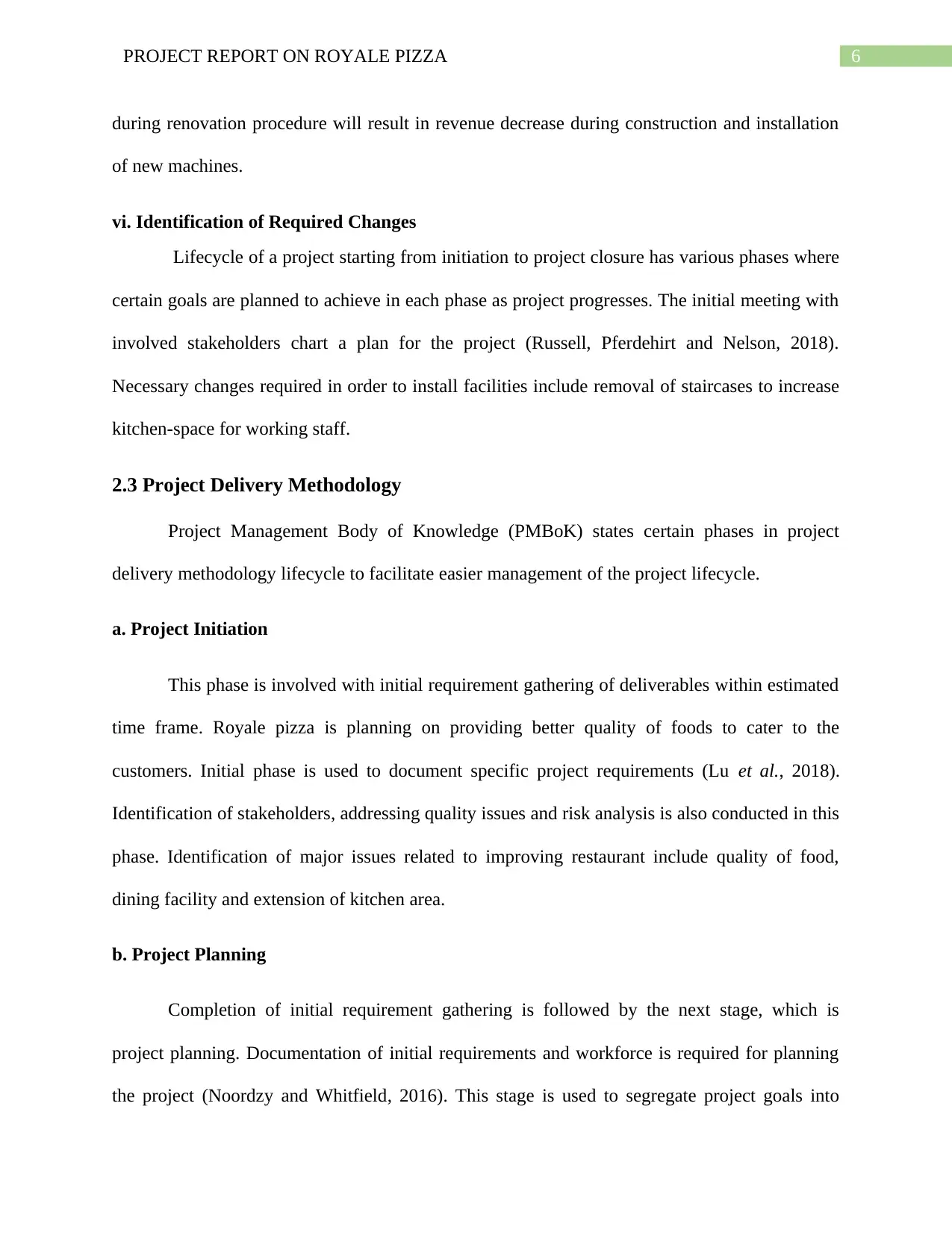
6PROJECT REPORT ON ROYALE PIZZA
during renovation procedure will result in revenue decrease during construction and installation
of new machines.
vi. Identification of Required Changes
Lifecycle of a project starting from initiation to project closure has various phases where
certain goals are planned to achieve in each phase as project progresses. The initial meeting with
involved stakeholders chart a plan for the project (Russell, Pferdehirt and Nelson, 2018).
Necessary changes required in order to install facilities include removal of staircases to increase
kitchen-space for working staff.
2.3 Project Delivery Methodology
Project Management Body of Knowledge (PMBoK) states certain phases in project
delivery methodology lifecycle to facilitate easier management of the project lifecycle.
a. Project Initiation
This phase is involved with initial requirement gathering of deliverables within estimated
time frame. Royale pizza is planning on providing better quality of foods to cater to the
customers. Initial phase is used to document specific project requirements (Lu et al., 2018).
Identification of stakeholders, addressing quality issues and risk analysis is also conducted in this
phase. Identification of major issues related to improving restaurant include quality of food,
dining facility and extension of kitchen area.
b. Project Planning
Completion of initial requirement gathering is followed by the next stage, which is
project planning. Documentation of initial requirements and workforce is required for planning
the project (Noordzy and Whitfield, 2016). This stage is used to segregate project goals into
during renovation procedure will result in revenue decrease during construction and installation
of new machines.
vi. Identification of Required Changes
Lifecycle of a project starting from initiation to project closure has various phases where
certain goals are planned to achieve in each phase as project progresses. The initial meeting with
involved stakeholders chart a plan for the project (Russell, Pferdehirt and Nelson, 2018).
Necessary changes required in order to install facilities include removal of staircases to increase
kitchen-space for working staff.
2.3 Project Delivery Methodology
Project Management Body of Knowledge (PMBoK) states certain phases in project
delivery methodology lifecycle to facilitate easier management of the project lifecycle.
a. Project Initiation
This phase is involved with initial requirement gathering of deliverables within estimated
time frame. Royale pizza is planning on providing better quality of foods to cater to the
customers. Initial phase is used to document specific project requirements (Lu et al., 2018).
Identification of stakeholders, addressing quality issues and risk analysis is also conducted in this
phase. Identification of major issues related to improving restaurant include quality of food,
dining facility and extension of kitchen area.
b. Project Planning
Completion of initial requirement gathering is followed by the next stage, which is
project planning. Documentation of initial requirements and workforce is required for planning
the project (Noordzy and Whitfield, 2016). This stage is used to segregate project goals into
Paraphrase This Document
Need a fresh take? Get an instant paraphrase of this document with our AI Paraphraser
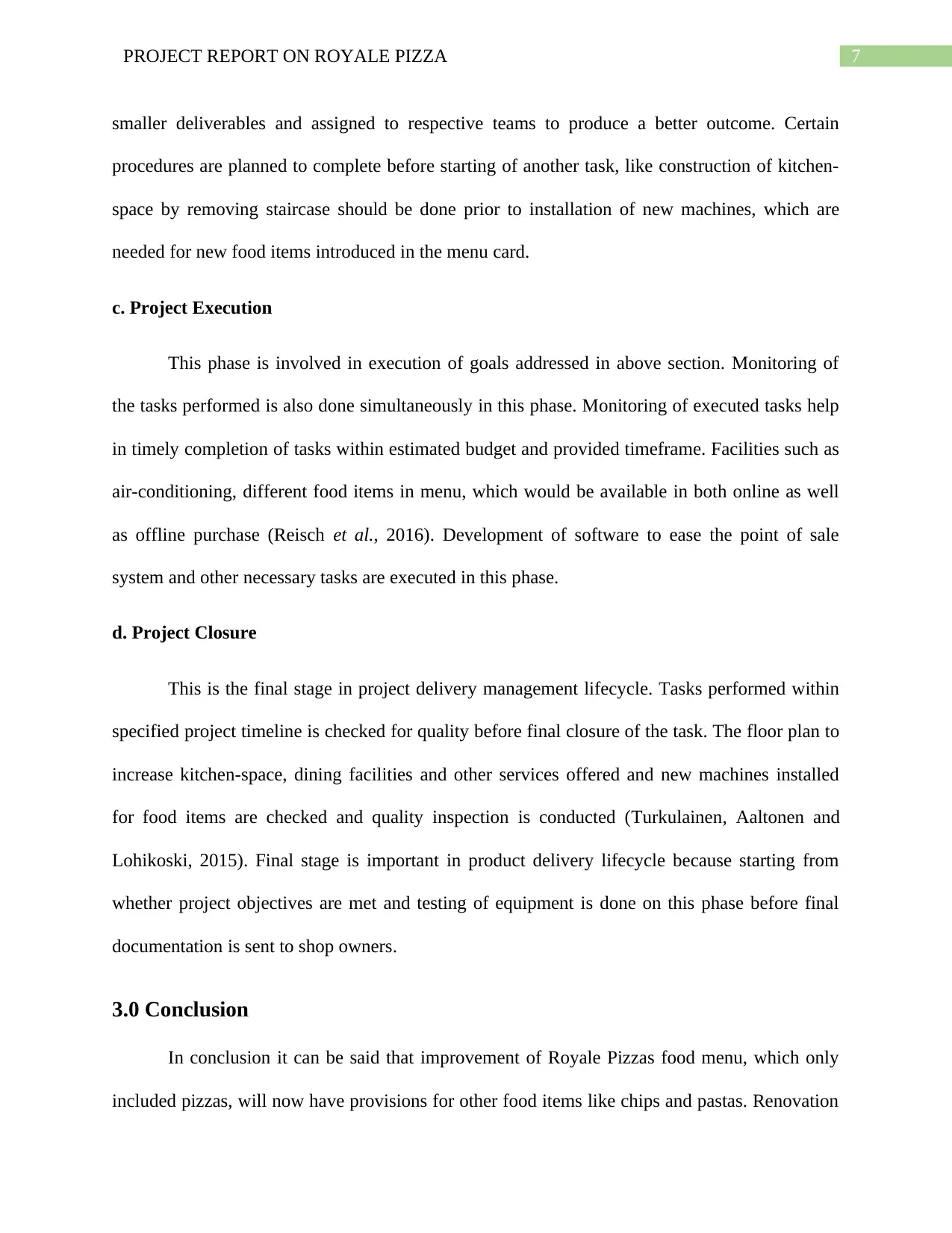
7PROJECT REPORT ON ROYALE PIZZA
smaller deliverables and assigned to respective teams to produce a better outcome. Certain
procedures are planned to complete before starting of another task, like construction of kitchen-
space by removing staircase should be done prior to installation of new machines, which are
needed for new food items introduced in the menu card.
c. Project Execution
This phase is involved in execution of goals addressed in above section. Monitoring of
the tasks performed is also done simultaneously in this phase. Monitoring of executed tasks help
in timely completion of tasks within estimated budget and provided timeframe. Facilities such as
air-conditioning, different food items in menu, which would be available in both online as well
as offline purchase (Reisch et al., 2016). Development of software to ease the point of sale
system and other necessary tasks are executed in this phase.
d. Project Closure
This is the final stage in project delivery management lifecycle. Tasks performed within
specified project timeline is checked for quality before final closure of the task. The floor plan to
increase kitchen-space, dining facilities and other services offered and new machines installed
for food items are checked and quality inspection is conducted (Turkulainen, Aaltonen and
Lohikoski, 2015). Final stage is important in product delivery lifecycle because starting from
whether project objectives are met and testing of equipment is done on this phase before final
documentation is sent to shop owners.
3.0 Conclusion
In conclusion it can be said that improvement of Royale Pizzas food menu, which only
included pizzas, will now have provisions for other food items like chips and pastas. Renovation
smaller deliverables and assigned to respective teams to produce a better outcome. Certain
procedures are planned to complete before starting of another task, like construction of kitchen-
space by removing staircase should be done prior to installation of new machines, which are
needed for new food items introduced in the menu card.
c. Project Execution
This phase is involved in execution of goals addressed in above section. Monitoring of
the tasks performed is also done simultaneously in this phase. Monitoring of executed tasks help
in timely completion of tasks within estimated budget and provided timeframe. Facilities such as
air-conditioning, different food items in menu, which would be available in both online as well
as offline purchase (Reisch et al., 2016). Development of software to ease the point of sale
system and other necessary tasks are executed in this phase.
d. Project Closure
This is the final stage in project delivery management lifecycle. Tasks performed within
specified project timeline is checked for quality before final closure of the task. The floor plan to
increase kitchen-space, dining facilities and other services offered and new machines installed
for food items are checked and quality inspection is conducted (Turkulainen, Aaltonen and
Lohikoski, 2015). Final stage is important in product delivery lifecycle because starting from
whether project objectives are met and testing of equipment is done on this phase before final
documentation is sent to shop owners.
3.0 Conclusion
In conclusion it can be said that improvement of Royale Pizzas food menu, which only
included pizzas, will now have provisions for other food items like chips and pastas. Renovation
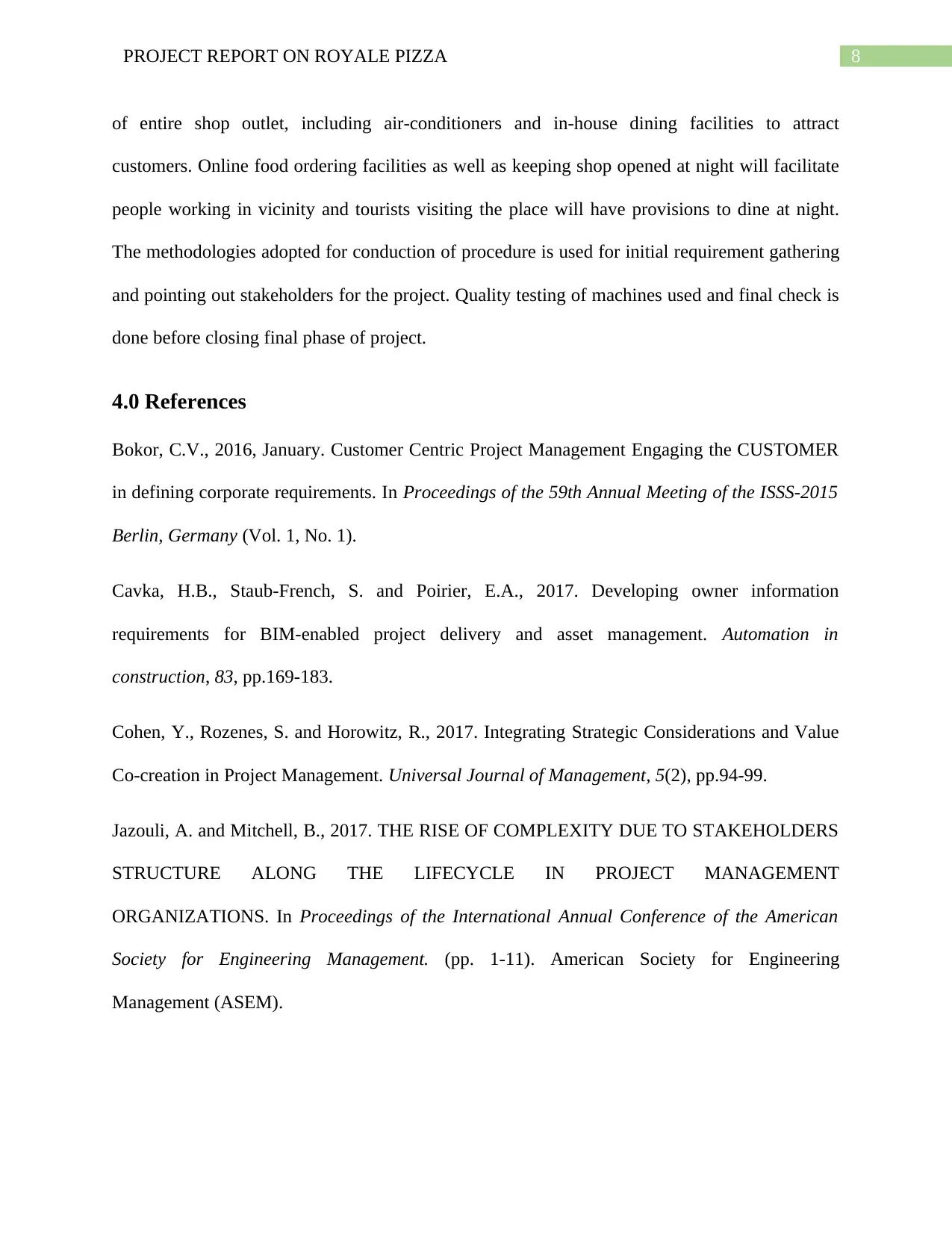
8PROJECT REPORT ON ROYALE PIZZA
of entire shop outlet, including air-conditioners and in-house dining facilities to attract
customers. Online food ordering facilities as well as keeping shop opened at night will facilitate
people working in vicinity and tourists visiting the place will have provisions to dine at night.
The methodologies adopted for conduction of procedure is used for initial requirement gathering
and pointing out stakeholders for the project. Quality testing of machines used and final check is
done before closing final phase of project.
4.0 References
Bokor, C.V., 2016, January. Customer Centric Project Management Engaging the CUSTOMER
in defining corporate requirements. In Proceedings of the 59th Annual Meeting of the ISSS-2015
Berlin, Germany (Vol. 1, No. 1).
Cavka, H.B., Staub-French, S. and Poirier, E.A., 2017. Developing owner information
requirements for BIM-enabled project delivery and asset management. Automation in
construction, 83, pp.169-183.
Cohen, Y., Rozenes, S. and Horowitz, R., 2017. Integrating Strategic Considerations and Value
Co-creation in Project Management. Universal Journal of Management, 5(2), pp.94-99.
Jazouli, A. and Mitchell, B., 2017. THE RISE OF COMPLEXITY DUE TO STAKEHOLDERS
STRUCTURE ALONG THE LIFECYCLE IN PROJECT MANAGEMENT
ORGANIZATIONS. In Proceedings of the International Annual Conference of the American
Society for Engineering Management. (pp. 1-11). American Society for Engineering
Management (ASEM).
of entire shop outlet, including air-conditioners and in-house dining facilities to attract
customers. Online food ordering facilities as well as keeping shop opened at night will facilitate
people working in vicinity and tourists visiting the place will have provisions to dine at night.
The methodologies adopted for conduction of procedure is used for initial requirement gathering
and pointing out stakeholders for the project. Quality testing of machines used and final check is
done before closing final phase of project.
4.0 References
Bokor, C.V., 2016, January. Customer Centric Project Management Engaging the CUSTOMER
in defining corporate requirements. In Proceedings of the 59th Annual Meeting of the ISSS-2015
Berlin, Germany (Vol. 1, No. 1).
Cavka, H.B., Staub-French, S. and Poirier, E.A., 2017. Developing owner information
requirements for BIM-enabled project delivery and asset management. Automation in
construction, 83, pp.169-183.
Cohen, Y., Rozenes, S. and Horowitz, R., 2017. Integrating Strategic Considerations and Value
Co-creation in Project Management. Universal Journal of Management, 5(2), pp.94-99.
Jazouli, A. and Mitchell, B., 2017. THE RISE OF COMPLEXITY DUE TO STAKEHOLDERS
STRUCTURE ALONG THE LIFECYCLE IN PROJECT MANAGEMENT
ORGANIZATIONS. In Proceedings of the International Annual Conference of the American
Society for Engineering Management. (pp. 1-11). American Society for Engineering
Management (ASEM).
⊘ This is a preview!⊘
Do you want full access?
Subscribe today to unlock all pages.

Trusted by 1+ million students worldwide
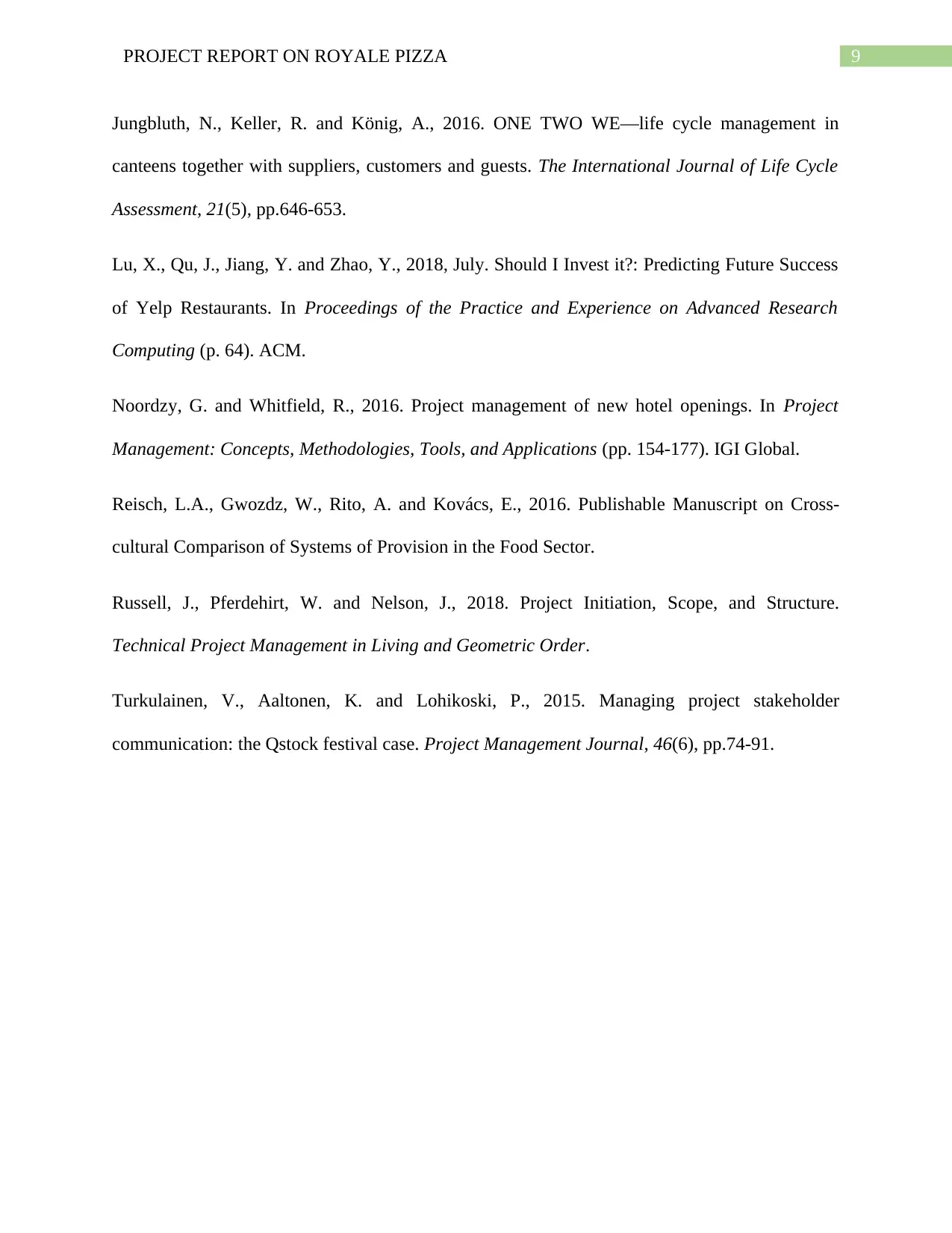
9PROJECT REPORT ON ROYALE PIZZA
Jungbluth, N., Keller, R. and König, A., 2016. ONE TWO WE—life cycle management in
canteens together with suppliers, customers and guests. The International Journal of Life Cycle
Assessment, 21(5), pp.646-653.
Lu, X., Qu, J., Jiang, Y. and Zhao, Y., 2018, July. Should I Invest it?: Predicting Future Success
of Yelp Restaurants. In Proceedings of the Practice and Experience on Advanced Research
Computing (p. 64). ACM.
Noordzy, G. and Whitfield, R., 2016. Project management of new hotel openings. In Project
Management: Concepts, Methodologies, Tools, and Applications (pp. 154-177). IGI Global.
Reisch, L.A., Gwozdz, W., Rito, A. and Kovács, E., 2016. Publishable Manuscript on Cross-
cultural Comparison of Systems of Provision in the Food Sector.
Russell, J., Pferdehirt, W. and Nelson, J., 2018. Project Initiation, Scope, and Structure.
Technical Project Management in Living and Geometric Order.
Turkulainen, V., Aaltonen, K. and Lohikoski, P., 2015. Managing project stakeholder
communication: the Qstock festival case. Project Management Journal, 46(6), pp.74-91.
Jungbluth, N., Keller, R. and König, A., 2016. ONE TWO WE—life cycle management in
canteens together with suppliers, customers and guests. The International Journal of Life Cycle
Assessment, 21(5), pp.646-653.
Lu, X., Qu, J., Jiang, Y. and Zhao, Y., 2018, July. Should I Invest it?: Predicting Future Success
of Yelp Restaurants. In Proceedings of the Practice and Experience on Advanced Research
Computing (p. 64). ACM.
Noordzy, G. and Whitfield, R., 2016. Project management of new hotel openings. In Project
Management: Concepts, Methodologies, Tools, and Applications (pp. 154-177). IGI Global.
Reisch, L.A., Gwozdz, W., Rito, A. and Kovács, E., 2016. Publishable Manuscript on Cross-
cultural Comparison of Systems of Provision in the Food Sector.
Russell, J., Pferdehirt, W. and Nelson, J., 2018. Project Initiation, Scope, and Structure.
Technical Project Management in Living and Geometric Order.
Turkulainen, V., Aaltonen, K. and Lohikoski, P., 2015. Managing project stakeholder
communication: the Qstock festival case. Project Management Journal, 46(6), pp.74-91.
1 out of 10
Related Documents
Your All-in-One AI-Powered Toolkit for Academic Success.
+13062052269
info@desklib.com
Available 24*7 on WhatsApp / Email
![[object Object]](/_next/static/media/star-bottom.7253800d.svg)
Unlock your academic potential
Copyright © 2020–2025 A2Z Services. All Rights Reserved. Developed and managed by ZUCOL.





